|
|
 |
|
Calanoida ( Order ) |
|
|
|
Diaptomoidea ( Superfamily ) |
|
|
|
Candaciidae ( Family ) |
|
|
|
Candacia ( Genus ) |
|
|
| |
Candacia longimana (Claus, 1863) (F,M) | |
| | | | | | | Syn.: | Candace longimana Claus, 1863 (p.190, figs.F,M); Giesbrecht, 1892 (p.423, 439, 771, figs.F,M);
Paracandacia longimana : Webber & al., 1996 (tab.1) | | | | Ref.: | | | Giesbrecht & Schmeil, 1898 (p.127, Rem. F,M); Thompson & Scott, 1903 (p.235, 250); A. Scott, 1909 (p.153, Rem.); Wolfenden, 1911 (p.356); Pesta, 1920 (p.538); Sars, 1925 (p.349); Rose, 1929 (p.39); Farran, 1929 (p.210, 270); Rose, 1933 a (p.251, figs.F,M); Farran, 1936 a (p.115); Mori, 1937 (1964) (p.79, figs.F,M); Wilson, 1942 a (p.175, fig.F); Sewell, 1947 (p.247); Farran, 1948 (n°13, p.3, figs.F,M); Fleminger & Bowman, 1956 (p.336, Rem., figs.M); Chiba & al., 1957 (p.310); 1957 a (p.11); Grice, 1962 (p.228, figs.F,M, Rem.); 1963 (p.177, figs.F,M, Rem.); Crisafi, 1963 (p.95, figs.F,M, juv.); Tanaka, 1964 c (p.245, figs.F,M); Vervoort, 1965 (p.163, Rem.); Owre & Foyo, 1967 (p.93, figs.F,M); Park, 1968 (p.567); Ramirez, 1969 (p., figs.F,M, Rem.); Corral Estrada, 1970 (p.199, figs.M, Rem.); Kos, 1972 (Vol. I, figs.F, M, Rem.); Lawson, 1977 (p.71, tab.2,3,4, fig.4, 5); Björnberg & al., 1981 (p.655, figs.F,M); Zheng & al., 1982 (p.62, figs.M); van der Spoel & Heyman, 1983 (p.33); Baessa De Aguiar, 1991 (1993) (p.102, fig.F); Chihara & Murano, 1997 (p.754, Pl.74,78: F,M); Mulyadi, 1997 a (p.95, Redescr.F, figs.F); Vaupel Klein & Gassmann, 1998 (p.443, fig.F); Bradford-Grieve & al., 1999 (p.885, 956, figs.F,M); Bradford-Grieve, 1999 b (p.169, figs.F,M, Rem., figs.183,193); Conway & al., 2003 (p.110, figs.F,M, Rem.); Boxshall & Halsey, 2004 (p.85: figs.F); Mulyadi, 2004 (p.92, figs.F, Rem.); Vives & Shmeleva, 2007 (p.452, figs.F,M, Rem.) | 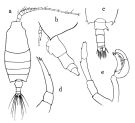 issued from : O. Tanaka in Publs Seto Mar. Biol. Lab., 1964, XII (3). [p.246, Fig.227]. Female: a, habitus (dorsal); b, last thoracic segment and urosome (left lateral side); c, idem (dorsal); d, P5. Nota: Abdomen contained 3.8 times in the length of the cephalothorax. Abdominal segments and caudal rami in the proportional length 48 : 26 : 6 : 20 = 100. A1 reaches back to the end of the thoracic segment. Male: e, P5.
|
 issued from : Bradford-Grieve J.M. in The Marine Fauna of New Zealand: Pelagic Calanoid Copepoda. National Institute of Water and Atmospheric Research (NIWA). NIWA Biodiversity Memoir, 111, 1999. [p.171, Fig.121]. Female: A, urosome (dorsal); B, idem (left lateral side); C, P5. Nota: The figures of the 2nd segment of urosome, and the shape of the ventral surface of genital somite (cf. Giesbrecht, 1892, tafel 39) show some differences between Pacific and Mediterranean specimens. Male: D, urosome (left lateral side); E, idem (dorsal); F, segments either side of \"knee\" joint on right A1; G, P5.
|
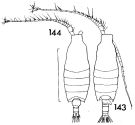 issued from : F.C. Ramirez in Contr. Inst. Biol. mar., Buenos Aires, 1969, 98. [p.86, Lam. XVII, figs.143, 144 ]. Female (from off Mar del Plata): 144, habitus (dorsal). Male: 143, habitus (dorsal). Scale bar in mm: 2.
|
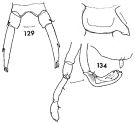 issued from : F.C. Ramirez in Contr. Inst. Biol. mar., Buenos Aires, 1969, 98. [p.80, Lam. XVI, figs.129, 134, 136]. Female (from off Mar del Plata): 129, P5. Male: 134, P5; 136, genital segment (dorsal). Scale bars in mm: 0.05 (129); 0.1 (134, 136);
|
 issued from : J. Corral Estrada in Tesis Doct., Univ. Madrid, A-129, Sec. Biologicas, 1970. [Lam.50, figs.7-10]. Male (from Canarias Is.): 7, posterior part cephalothorax and genital segment (dorsal); 8, idem (lateral right side); 9, P5; 10, distal part of right P5.
|
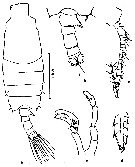 issued from : Z. Zheng, S. Li, S.J. Li & B. Chen in Marine planktonic copepods in Chinese waters. Shanghai Sc. Techn. Press, 1982 [p.62, Fig.35]. Male: a, habitus (dorsal); b, urosome (dorsal); c, forehead and right A1 (dorsal); d, 3rd exopodal segment of P3; e, P5.
|
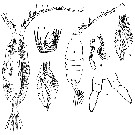 issued from : T. Mori in The Pelagic copepoda from the neighbouring waters of Japan, 1937 (1964). [Pl. 53, Figs.1-7]. Female: 1, habitus (dorsal); 2, Mx2: 3, P3; 7, P5. Male: 4, habitus (dorsal); 5, P5; 6, P3.
|
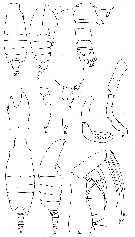 issued from : G.D. Grice in Fish. Bull. Fish and Wildl. Ser., 1962, 61. [p.229, Pl.28, Figs.1-12]. Female (from W tropical Pacific): 1-2, habitus (dorsal and lateral, respectively); 3, Md (biting edge); 4, P5; 5, tip of P5. Nota: Genital segment symmetrical. Basal tooth od Md tricuspate. P5 terminates in a 3 sub-equal points Male: 6-7, habitus (dorsal and lateral, respectively); 8, posterior part of thorax and urosome (dorsal); 9, posterior lateral corner of thorax and genital segment (right side); 10, Mx2; 11, right P5; 12, left P5. Nota: The right posterior thoracic margin ends in an irregular protrusion which in lateral view is seen to turn upward. The right side of the genital segment has a large finger-like protrusion. Right P5 chelate and the distal margin of the last segment of left P5 ends in 3 small points.
|
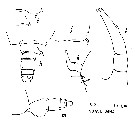 issued from : A. Fleminger & T.E. Bowman in Proc. U.S. Natn. Mus. 1956, 106, No 3370. [p.335, Fig.2, h-m]. Female (from off N Carolina): l, P5; m, urosome (lateral, left side). Male (from S Pacific): h, urosome (dorsal); i, portion of 5th thoracic segment and 1st urosomal segment (dorsal). Male (from off Chile): j, posterior corner of right 5th thoracic segment (dorsal); k, same (lateral).
|
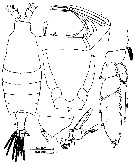 issued from : Mulyadi in Published by Res. Center Biol., Indonesia Inst. Sci. Bogor, 2004. [p.92, Fig.51]. Female (from 07°29'S, 121°05'E): A, habitus (dorsal); B, 5th metasomal somite and urosome, with spermatophore (lateral left side); C, Mx2; D, P3; E, P5 (anterior view). Nota: The female is identifiable in having 3 very short teeth at the apex of exopod of P5.
|
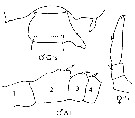 Issued from : J.M. Bradford-Grieve, E.L. Markhaseva, C.E.F. Rocha & B. Abiahy in South Atlantic Zooplankton, edit. D. Boltovskoy. 1999, Vol. 2, Copepoda; [p.1065, Fig. 7.368 : Candacia longimana ]. Gns = genital segment. Female characteristics : Apex of terminal segment of P5 with 3 subequal minute spine-like points. No spine-like process present on ventral side of genital segment Male characteristics: In dorsal view, process on genital segment knob-like on right side.
|
 Issued from : W. Giesbrecht in Fauna Flora Golf. Neapel, 1892, 19. [Taf. 39, figs. 4, 6, 18]. As Candace longimana. Female: 4, habitus (dorsal); 6, same (lateral); 18, caudal rami (ventral).
|
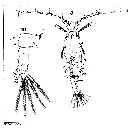 Issued from : W. Giesbrecht in Fauna Flora Golf. Neapel, 1892, 19. [Taf. 39, figs. 5, 19]. As Candace longimana. Male: habitus (dorsal); 19, posterior part of last thoracic segment and urosome (dorsal).
| | | | | Compl. Ref.: | | | Rose, 1926 (p.47); Massuti Alzamora, 1942 (p.111); Lysholm & al., 1945 (p.41); Sewell, 1948 (p.346, 408, 417, 418, 426, 427, 433, 443, 457, 460, 470, 475, 506); C.B. Wilson, 1950 (p.181); Yamazi, 1958 (p.151, Rem.); Fagetti, 1962 (p.33); Grice & Hart, 1962 (p.287, table 3); V.N. Greze, 1963 a (tabl.2); Grice, 1963 a (p.496); De Decker & Mombeck, 1964 (p.11); Gobillard, 1964 (p.107, Eugregarine infestation); Grice & Hulsemann, 1965 (p.225); Shmeleva, 1965 b (p.1350, lengths-volume-weight relation); Mazza, 1966 (p.72); Furuhashi, 1966 a (p.295, vertical distribution in Oyashio/Kuroshio transitional area, Table 8, 9); Grice & Hulsemann, 1967 (p.19); Fleminger, 1967 a (tabl.1); Delalo, 1968 (p.138); Séguin, 1968 (p.488); Morris, 1970 (p.2301); Park, 1970 (p.478); Roe, 1972 (p.277, tabl.1, 2); Apostolopoulou, 1972 (p.328, 366); Björnberg, 1973 (p.349, 385); Corral Estrada & Pereiro Muñoz, 1974 (tab.I); Tranter, 1977 (p.596, 600); Deevey & Brooks, 1977 (p.156, tab.2, Station "S"); Carter, 1977 (1978) (p.36); Vaissière & Séguin, 1980 (p.23, tab.2); Kovalev & Shmeleva, 1982 (p.85); Vives, 1982 (p.294); Dessier, 1983 (p.89, Tableau 1, Rem., %); Scotto di Carlo & al., 1984 (1044); Guangshan & Honglin, 1984 (p.118, tab.); Cummings, 1984 (p.163, Table 2); Petipa & Borichenko, 1985 (tab.1,2); Brenning, 1985 a (p.28, Table 2); Madhupratap & Haridas, 1986 (p.105, tab.1); Ambler & Miller, 1987 (tab.2, 3); Brenning, 1987 (p.29, spatial distribution, T-S diagram, Rem.); Lozano Soldevilla & al., 1988 (p.60); Heinrich, 1990 (p.19); Suarez & al., 1990 (tab.2); Scotto di Carlo & al., 1991 (p.271); Ohtsuka & Kubo, 1991 (p.541); Suarez & Gasca, 1991 (tab.2); Suarez, 1992 (App.1); Seguin & al., 1993 (p.23); Shih & Young, 1995 (p.69); Jamet & Ferec-Corbel, 1996 (p.17, tab.1); Park & Choi, 1997 (Appendix); Errhif & al., 1997 (p.422); Hure & Krsinic, 1998 (p.102); Suarez-Morales & Gasca, 1998 a (p108); Lopez-Salgado & al., 2000 (tab.1); Moraitou-Apostolopoulou & al., 2000 (tab.I); Lapernat, 2000 (tabl.3, 4); El-Sherif & Aboul Ezz, 2000 (p.61, Table 3: occurrence); Beaugrand & al., 2002 (p.179, figs.5, 6); Hsiao & al., 2004 (p.325, tab.1); Daly Yahia & al., 2004 (p.366, fig.4); Osore & al., 2004 (p.195); Pusch & al., 2004 (251, tab.3); Lo & al., 2004 (p.89, tab.1); Berasategui & al., 2005 (p.313, fig.2); Lopez-Ibarra & Palomares-Garcia, 2006 (p.63, Tabl. 1, seasonal abundance vs El-Niño); Khelifi-Touhami & al., 2007 (p.327, Table 1); Hwang & al., 2007 (p.23); Dur & al., 2007 (p.197, Table IV); Neumann-Leitao & al., 2008 (p.799: Tab.II, fig.6); Gaard & al., 2008 (p.59, Table 1, N Mid-Atlantic Ridge); C.-Y. Lee & al., 2009 (p.151, Tab.2); Williamson & McGowan, 2010 (p.273, Table 3, Pacific central gyres: N and S); Hidalgo & al., 2010 (p.2089, Table 2); Mazzocchi & Di Capua, 2010 (p.424); Medellin-Mora & Navas S., 2010 (p.265, Tab. 2); Hsiao S.H. & al., 2011 (p.475, Appendix I); Salah S. & al., 2012 (p.155, Tableau 1); Uysal & Shmeleva, 2012 (p.909, Table I); Takenaka & al., 2012 (p.1669, fig.2, 3, Table 1, bioluminescence); in CalCOFI regional list (MDO, Nov. 2013; M. Ohman, pers. comm.); Zaafa & al., 2014 (p.67, Table I, occurrence); Bonecker & a., 2014 (p.445, Table II: frequency, horizontal & vertical distributions); Zakaria & al., 2016 (p.1, Table 1); Benedetti & al., 2016 (p.159, Table I, fig.1, functional characters); Marques-Rojas & Zoppi de Roa, 2017 (p.495, Table 1); El Arraj & al., 2017 (p.272, table 2, spatial distribution); Benedetti & al., 2018 (p.1, Fig.2: ecological functional group); Belmonte, 2018 (p.273, Table I: Italian zones); Chaouadi & Hafferssas, 2018 (p.913, Table II: occurrence); Acha & al., 2020 (p.1, Table 3: occurrence % vs ecoregions). | | | | NZ: | 17 | | |
|
Distribution map of Candacia longimana by geographical zones
|
| | | | | | | | | | | | 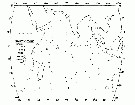 issued from : T.J. Lawson in Marine Biology, 1977, 43. [Fig.5, p.81]. issued from : T.J. Lawson in Marine Biology, 1977, 43. [Fig.5, p.81].
Distribution map for the Indian Ocean. |
 issued from : Mulyadi in Treubia, 1997, 31 (2). [p.109, Fig.16]. issued from : Mulyadi in Treubia, 1997, 31 (2). [p.109, Fig.16].
Distribution of Candaciidae in Indonesian waters. 9: C. longimana. |
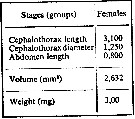 issued from : A.A. Shmeleva in Bull. Inst. Oceanogr., Monaco, 1965, 65 (n°1351). [Table 6: 34 ]. Candacia longimana (from South Adriatic). issued from : A.A. Shmeleva in Bull. Inst. Oceanogr., Monaco, 1965, 65 (n°1351). [Table 6: 34 ]. Candacia longimana (from South Adriatic).
Dimensions, volume and Weight wet. Means for 50-60 specimens. Volume and weight calculated by geometrical method. Assumed that the specific gravity of the Copepod body is equal to 1, then the volume will correspond to the weight. |
 issued from : U. Brenning in Wiss. Z. Wilhelm-Pieck-Univ. Rostock - 36. Jahrgang 1987. Mat.-nat. wiss. Reihe, 2. [p.27, Fig.1]. issued from : U. Brenning in Wiss. Z. Wilhelm-Pieck-Univ. Rostock - 36. Jahrgang 1987. Mat.-nat. wiss. Reihe, 2. [p.27, Fig.1].
Spatial distribution for Candacia curta, C. armata, C. bipinnata, C. paenelongimana, C. varicans (as varians), C. pachydactyla, C. longimana, C. ethiopica, Paracandacia simplex ( = C. simplex) from 8° S - 26° N; 16°- 20° W, for different expeditions (V1: Dec. 1972- Jan. 1973; V2: Feb/Mar. 1973; VI: May 1974; IV: Jun./Jul. 1972). |
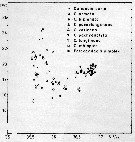 issued from : U. Brenning in Wiss. Z. Wilhelm-Pieck-Univ. Rostock - 36. Jahrgang 1987. Mat.-nat. wiss. Reihe, 2. [p.28, Fig.2]. issued from : U. Brenning in Wiss. Z. Wilhelm-Pieck-Univ. Rostock - 36. Jahrgang 1987. Mat.-nat. wiss. Reihe, 2. [p.28, Fig.2].
T-S Diagram for Candacia curta, C. armata, C. bipinnata, C. paenelongimana, C. varicans, C. pachydactyla, C. longimana, C. ethiopica, Paracandacia simplex ( = C. simplex) from 8° S - 26° N; 16°- 20° W. |
| | | | Loc: | | | South Africa (E), off N St. Helena Is., off S Ascension Is., off Liberia, off NE St. Paul Is., Sao Tomé, N Cape Verde Is., off NW Cape Verde Is., off Morocco-Mauritania, Cap Ghir, Great Meteor Seamount, Canary Is., off Madeira, Azores, Portugal, Bay of Biscay, off SW Ireland, off S Iceland, Argentina, Brazil, off Amazon, Caribbean Sea, Caribbean Colombia, Bahia de Mochima (Venezuela), Jamaica, G. of Mexico, Cuba, Florida, Sargasso Sea, off Bermuda (Station "S"), Medit. (M'Diq, Alboran Sea, Sidi Fredj coast, Algiers, NW, Baleares, G. of Lion, Ligurian Sea, Tyrrhenian Sea, Messina, NW Tunisia, Adriatic Sea, Ionian Sea, Aegean Sea, W Egyptian coast, Lebanon Basin), Sharm El-Sheikh, Safaga, Red Sea, G. of Aden, Arabian Sea, Madagascar (Nosy-Bé), off Kenya, S Indian (subtropical convergence), W Australia, Indonesia-Malaysia (Sunda Strait, Flores Sea, Celebes Sea), Philippines, China Seas (East China Sea, South China Sea), Taiwan, Kuroshio Current, Japan Sea, Japan, Tanabe Bay, Izu region, S Hokkaido, Bikini Is., Pacif. (W tropical), Pacif. (W equatorial), Pacific (central gyres: N and S), Australia (W & Great Barrier Reef), New Zealand (Cook Strait, North Island N), Hawaii, off Hawaii NE, California, Baja California (Bahia Magdalena), Central America, W Ecuador, S Galapagos, E Easter Is., Chile (N-S) | | | | N: | 152 (S Atlant.: 10; N Atlant.: 48; Medit.: 33; Red Sea: 3; Indian: 18; Indo-Malaysia: 5; Pacif.: 33) | | | | Lg.: | | | (16) F: 3,5-2,9; M: 3,15-2,4; (34) F: 3,25-2,95; M: 3,24-2,45; (35) F: 3,9-3,7; M: 3,5-3,35; (46) F: 3,9-3,6; M: 3,5-3,1; (72) M: 3,55-3,19; (101) F: 2,92-2,82; M: 2,69; (120) F: 3; M: 2,94; (180) M: 3,19-3; (199) F: 3,27-3,04; M: 3,19-2,96; (254) F: ± 3.1; M: ± 3.1; (342) F: 3,761-3,131; M: 3,717-3,054; (449) F: 3,9-3,6; M: 3,5-3,1; (778) F: 2,7; (909) F: 2,86-3,33; M: 3,1-3,4; (991) F: 2,86-3,9; M: 2,4-3,55; (1023) M: 3,06-3,16; (1110) F: 3,3; (1122) F: 2,7; (1230) F: 3,0-3,7; M: 2,94-3,3; {F: 2,70-3,90; M: 2,40-3,72}
The mean female size is 3.276 mm (n = 25; SD = 0.4089), and the mean male size is 3.161 mm (n = 17; SD = 0.3437). The size ratio (male : female) is 0.95 (n = 11; SD = 0.0569). | | | | Rem.: | epi-mesopelagic. Overall Depth Range in Sargasso Sea: 0-2000 m. 0-197 m at Station S 2 in S Bösö (E middle Japan).
See Nota in Fleminger & Bowman figures' in C. paenelongimana.
After Benedetti & al. (2018, p.1, Fig.2) this species belonging to the functional group 1 corresponding to large sac-spawning carnivorous.
For Acha & al. (2020) this species is observed Northern offshore and shelfbreak in front of Rio de La Plata (Argentina).
See in DVP Conway & al., 2003 (version 1) | | | Last update : 19/06/2023 | |
|
|
 Any use of this site for a publication will be mentioned with the following reference : Any use of this site for a publication will be mentioned with the following reference :
Razouls C., Desreumaux N., Kouwenberg J. and de Bovée F., 2005-2025. - Biodiversity of Marine Planktonic Copepods (morphology, geographical distribution and biological data). Sorbonne University, CNRS. Available at http://copepodes.obs-banyuls.fr/en [Accessed January 05, 2026] © copyright 2005-2025 Sorbonne University, CNRS
|
|
 |
 |





















